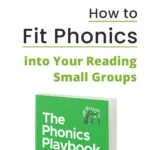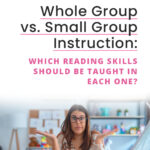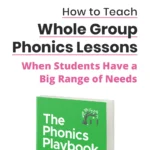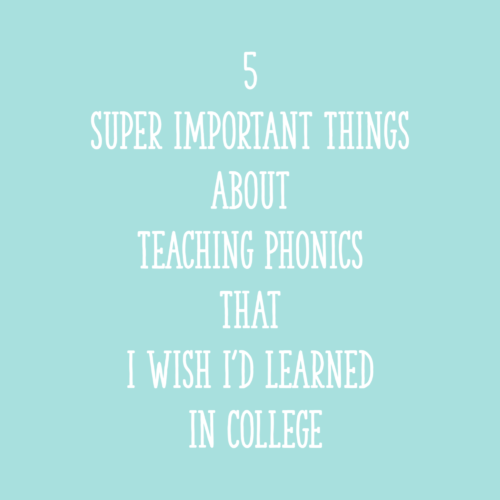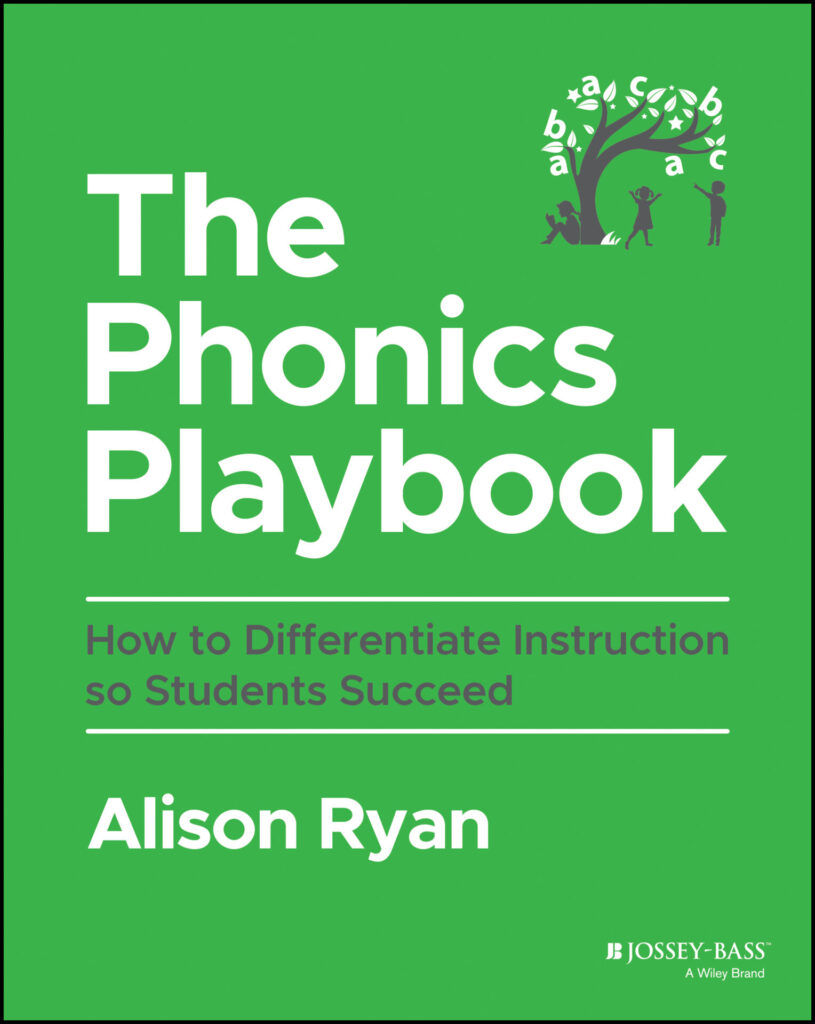Instruction in phonics small groups can help maximize differentiation for your students. In a small group setting, you’re able to tailor the instruction to better address students’ needs. It can often be easiest to meet a big range of needs by doing most phonics instruction in a small-group setting. However, the success of these groups requires careful planning to ensure effectiveness and avoid common pitfalls.
(Note: Having phonics covered in mostly small groups is just one model for implementing differentiated phonics instruction. In my book, The Phonics Playbook, I cover in detail 3 effective models for helping you differentiate your phonics instruction.)
In this blog post, I’ll provide practical tips for creating and executing phonics small groups.
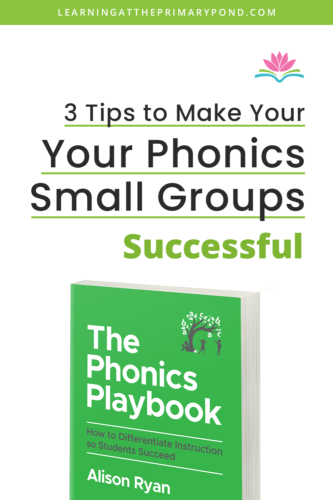
Tip #1: Assess Students’ Needs
One mistake I’ve seen teachers make is to assume that because a student is more advanced or maybe slightly behind in reading, that means they are in a similar place with phonics. For instance, a student might have really high comprehension during read alouds and contribute insightful thoughts to discussions. This is wonderful, but it does not equate to being advanced in phonics. (Having a text read to you is different than being able to actually read that text, and many kids who struggle with decoding do not struggle with comprehension.)
It’s also possible, and relatively common, for a child to be much stronger in decoding than they are in spelling. Spelling weaknesses should be addressed in phonics instruction just as much as decoding weaknesses.
To make sure you accurately group students, begin by assessing phonics skills through diagnostic assessments and informal observations. In The Phonics Playbook, I included a thorough diagnostic phonics assessment you can use with students. It covers areas such as:
- letter name and letter sound knowledge
- word reading
- spelling
This particular diagnostic assessment covers a range of skills, all the way from CVC words to words with Greek and Latin roots! The assessment data will allow you to identify areas of strength and areas needing improvement. Not only will this help you form student groups, but it will also give you a starting point for content.
Just as a side note: I recommend limiting the amount of small groups to 3. Any more than that and it can feel overwhelming to plan for. Also, more groups = less instructional time per group. In other words, if you have a 45 minute block and 3 groups, they’d each get about 15 minutes. If you have 5 groups, they’d only get 9 minutes of instruction with you, and that’s not even accounting for transition time.
Additionally, your groups can and should be flexible as time goes on! With up to date assessments/data and new informal observations, students can move to different groups throughout the year.
Tip #2: Use the small group time for what matters most!
If you’ve ever led a small group, you know that time FLIES. One rotation can go by in the blink of an eye. Every minute matters, and you want to ensure that you spend those minutes on differentiated instruction. (In The Phonics Playbook, I provide tons of sample schedules to help with this.)
One way to maximize small group instruction time is to cover certain skills in whole group instruction. Here’s an example of what this could look like in a Kindergarten classroom:
First, all students gather on the carpet for whole group instruction.
- The teacher spends 2-3 minutes on a phonemic awareness activity where students practice blending and segmenting words with 3 sounds.
- Then the teacher leads 1 minute of review on some tougher letter names and sounds.
- Finally, the teacher introduces a new high frequency word. Students say their own sentences using the new word, discuss the sounds, and then see the relationship between sounds and letters for the high frequency word. This process takes about 5-6 minutes.
All in all, the phonics whole group instruction outlined above takes 8-10 minutes. On the contrary, teaching or practicing the same skill multiple times in different small groups would be time-consuming and inefficient.
Continuing with the example above, here’s what each group might work on in their small group setting with the teacher:
- Group 1: First, students play a review game focused on letter names and sounds that still are not mastered. Next, they do some multisensory tracing of alphabet letters. Last, the teacher models how to decode a CVC word.
- Group 2: Students quickly review the vowel name/short vowel sound for the letter “o.” Next, they blend some short “o” CVC words with support. Lastly, they build short “o” CVC words with magnetic tiles.
- Group 3: This group first completes a quick picture sort of the digraphs “sh” and “ch.” Students then build words with the “sh” digraph. Finally, they reread those “sh” digraph words to a partner.
Within the 45-50 minute block outlined, students practiced phonemic awareness, review, a high frequency word, PLUS differentiated decoding and encoding practice.
Tip #3: Make sure independent work time is meaningful.
Just as the instruction students receive during small groups is important, the activities students do during independent work are also important! You want to ensure that the skills they are working on are tailored to their current levels of phonics development.
With small group phonics, the teacher needs his/her focus to be mainly on the instructional group. Therefore, the rest of the class must be productively engaged in practicing skills on their own. This sounds great in theory but can be a bit difficult in practice, especially when working with young children! Lots of modeling, practice, and setting clear expectations are key.
What are students working on independently?
Many kindergarten and first-grade students need to spend a great deal of their independent time on phonics, phonological awareness, and decoding activities. However, this might also be a time when students (especially those reading at least somewhat fluently) can practice other skills that you’re teaching throughout your literacy block.
For example, students might read with a partner and give each other feedback on their fluency. Students might also work on writing projects during this time, or listen to audio books and answer comprehension questions.
When selecting activities, consider the skills students have been working on recently. For instance, if you just finished covering short “a” with a small group, have those students read and/or spell words with short “a” and reread decodable texts with short “a” words.
This means that you might want to have different tasks for different groups of students, which you can accomplish with color-coded bins or folders. Some tasks (such as a writing activity) can be completed by all students, so not all of your independent activities need to be differentiated.
Regardless of the task, make sure that students are familiar with it (preferably because they have already done it with you or you have at least modeled it) and that the activity covers skills that students have already been taught.
How do I structure independent time?
Another important question is, “How do I structure independent time?” Although there is no single correct way to organize this block of time, here are some logistical considerations:
- Where will students do their activities? Will you have fixed centers or stations throughout the classroom, or will children bring materials to their seats?
- How will you set up groups? Will students work in partners, small groups, alone, or a combination?
- If you’re using partner or group work, will students work in similar-ability or mixed-ability groups?
- How will students know which center to visit or which activities to complete?
- How will students change activities or rotate between centers?
- How will you ensure that students are doing what they are supposed to be doing during independent work time?
There is a lot to think about here, and there’s not typically a right or wrong answer to these questions. Sometimes testing out an organizational system is the only way to determine if it works for you! (And my 2 cents? Make your system as easy as possible, because you have enough on your plate as it is!)
Conclusion
There’s a lot to think about and consider when it comes to making your phonics small groups successful. By implementing some of the strategies above, you can create inclusive and effective phonics instruction that supports all learners in developing essential literacy skills. Remember, the ultimate goal is to empower every student to become confident and proficient readers and writers, regardless of their starting point!
Want to dig into this topic in more detail? The Phonics Playbook is packed with research-backed differentiation strategies for K-3 teachers! This guide will help differentiate your phonics instruction so that ALL students succeed! Grab your copy here!
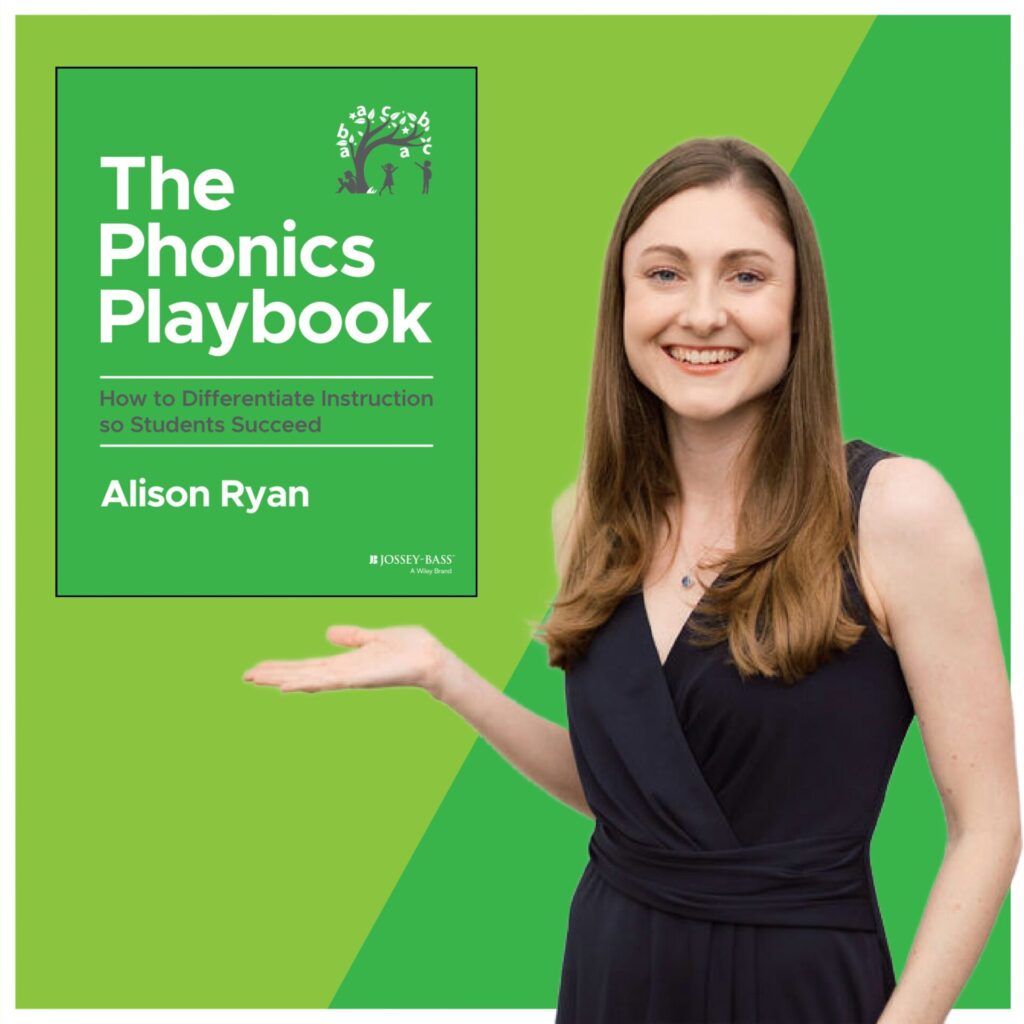
Happy teaching!

